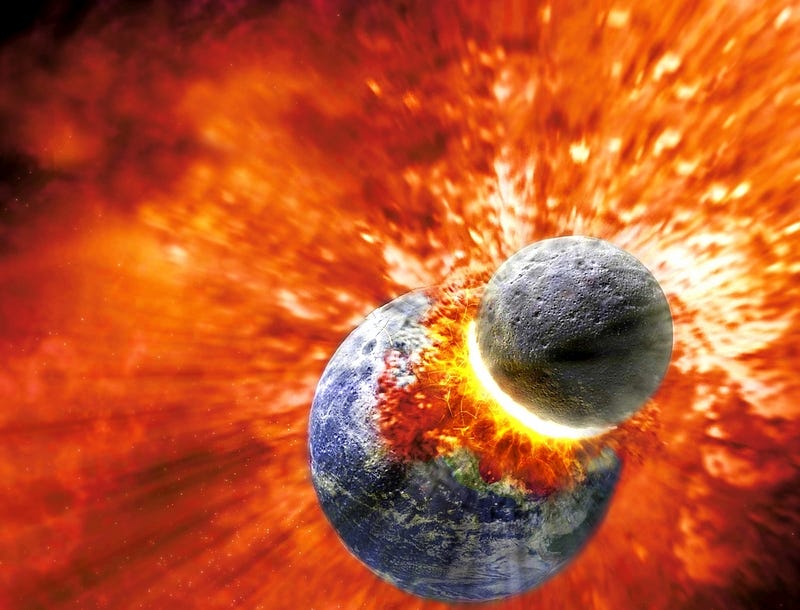The Connection Between Earth's Interior and an Ancient Collision
Written on
Chapter 1: The Enigma of Earth's Interior
For decades, the presence of blobs in Earth's mantle has intrigued geologists. A recent study sheds light on this mystery, linking these formations to an ancient planet that collided with Earth, resulting in the Moon's creation.
As I reflect on my time in Ottawa during the late 1980s, I recall the Australian rock band INXS and their hit song, "Never Tear Us Apart," which features the memorable line about “two worlds colliding.” This lyrical notion resonates with a scientific hypothesis suggesting that the Earth and Moon originated from an actual collision between two celestial bodies in the early solar system.
According to the giant-impact hypothesis, a planet similar to Mars, referred to as Theia, collided with the primordial Earth. This cataclysmic event ejected debris from both planets into space, which eventually formed the Moon after cooling and solidifying.
The collision not only generated immense heat but also contributed to the formation of Earth's early atmosphere. It is believed that this impact melted the lunar surface, which explains the Moon's volcanic history.
Dr. Qian Yuan, who studies dynamic processes within Earth's interior, is currently a postdoctoral scholar at the California Institute of Technology, CalTech, under Professor Paul Asimow. He has been investigating two large blobs located near Earth's core, each remarkably twice the size of the Moon. One blob resides beneath Africa, while the other is positioned beneath the Pacific Ocean.
The primary interest for Professor Yuan lies in the hypothesis that these blobs are remnants of the ancient planet Theia. His recent study, published in the journal Nature, posits that Earth absorbed the majority of Theia during their collision, which accounts for the absence of Theia fragments in the asteroid belt or meteorites.
Section 1.1: Understanding the Blobs
The existence of these blobs came to light in the 1980s, coinciding with the popularity of INXS's song. Seismic wave measurements revealed distinct three-dimensional variations deep within Earth's structure, suggesting that these blobs have unusually high iron concentrations, making them denser than the surrounding mantle and resulting in slower seismic wave speeds.
During a seminar by Professor Mikhail Zolotov at Arizona State University, Professor Yuan had a breakthrough realization. He linked the high iron content of the Moon with the missing planet Theia, leading him to hypothesize that the iron-rich impactor may have transformed into these mantle blobs.
Subsection 1.1.1: The Formation of the Blobs

By collaborating with scientists across various fields, Yuan's team conducted simulations confirming that Theia's collision with Earth resulted in the formation of both the Moon and the two mantle blobs. They theorize that Theia had a molten iron-rich mantle akin to Earth's, which merged into the two dense blobs as a result of the impact.
The formation of these blobs is attributed to the upper mantle of Earth absorbing most of the impact energy, while the lower mantle remained relatively intact. The blobs maintained their shape and sank close to the base of the lower mantle, largely untouched by external forces.
Section 1.2: The Implications of Discovery
Understanding these ancient blobs provides insights into Earth's geological history and evolution. Researchers aim to explore how these formations may influence mantle convection and consequently affect plate tectonics, which drive continental drift and seismic activity.
Professor Asimow, the head of the laboratory and a co-author of the study, remarked on the significance of linking the large low-velocity provinces (LLVPs) with Theia's remnants, emphasizing their potential role in Earth's early evolution, including the onset of subduction processes, the formation of the first continents, and the origins of the oldest terrestrial minerals.
Chapter 2: Further Exploration
The quest for knowledge continues as scientists strive to unveil the mysteries of Earth's interior.
This video titled "The Remains of an Ancient Planet Lie Deep Within Earth" delves deeper into the connection between these interior structures and the ancient collision.
Additionally, the video "Mysterious Giant Blobs of Material Near Earth's Core" explores the implications of these discoveries on our understanding of Earth's geological processes.
We have much more to learn about our planet and its history, and this discovery is just the beginning of a fascinating journey into Earth’s geological past.

I am a freelance writer and content creator, offering services to select business clients. My expertise encompasses content marketing, technical writing, and training, drawing from extensive experience with some of Canada's leading organizations. View all posts by David Morton Rintoul Originally published at http://daretoknow.ca on November 17, 2023.